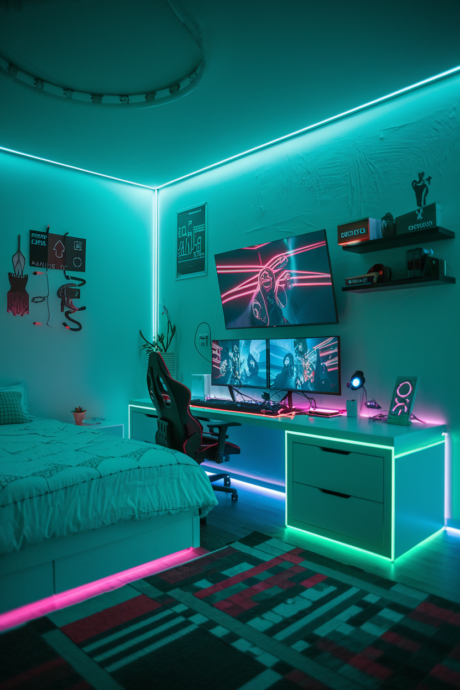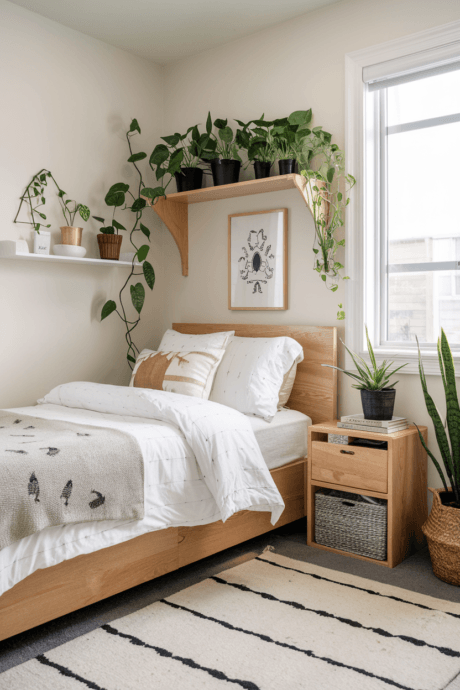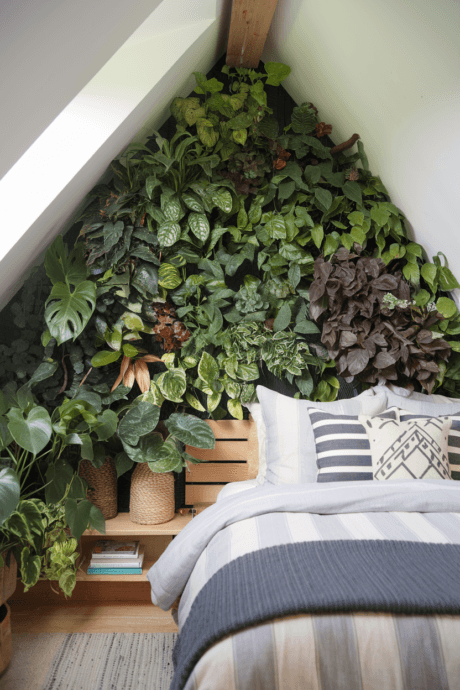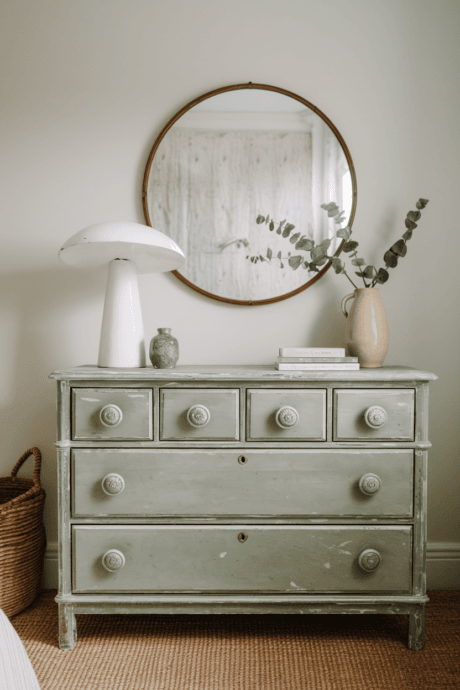In a world saturated with bright, airy spaces, there’s something undeniably alluring about the depth and sophistication of a moody neutral living room. These spaces whisper rather than shout, inviting you to sink into their embrace and truly unwind. The beauty of moody neutrals lies in their versatility—they create spaces that feel both timeless and contemporary, sophisticated and comfortable, dramatic yet serene.
This collection of 20 moody neutral living room ideas explores the nuanced palette of earthy tones, smoky grays, muted browns, and soft blacks that create spaces with depth, character, and lasting appeal. From textural layering to strategic lighting, discover how to transform your living room into a cocooning retreat that balances dramatic flair with understated elegance.
1. Charcoal and Cream Contrast

Balance is key in this design, where deep charcoal walls create a dramatic backdrop for cream-colored furniture. The stark contrast between dark and light creates visual interest while maintaining a strictly neutral palette. Add texture through ribbed throw pillows and a bouclé accent chair to prevent the space from feeling flat or one-dimensional.
2. Layered Textile Haven

Create depth through thoughtful layering of textiles in varying neutral tones. A chunky knit throw draped over a linen sofa, set against velvet cushions in gradating shades from ivory to chocolate creates tactile dimension. Complete the look with a low-pile wool rug in a subtle geometric pattern that ties all the tones together.
3. Architectural Shadow Play

Emphasize architectural features by painting them in deep, moody tones that contrast with lighter walls. Think charcoal ceiling beams against greige walls, or matte black window frames that stand out against putty-colored surroundings. This creates natural shadow play that adds depth and interest even without additional decorative elements.
4. Terra Cotta Accents

Warm up a cool-toned neutral space with terra cotta accents that add subtle color without breaking the neutral theme. A collection of handmade pottery, rust-colored throw pillows, or a statement leather ottoman in burnished sienna can breathe life into a palette of grays and taupes while maintaining the room’s earthy character.
5. Monochromatic Texture Story

Commit to a single color family—perhaps warm taupe or cool gray—and create interest through wildly varying textures. Picture a room where everything from walls to furniture falls within the same tight color range, but materials range from glossy ceramic and brushed brass to nubby linen and rough-hewn wood.
6. Scandinavian Moody Minimalism

Combine Scandinavian simplicity with moody undertones for a sophisticated take on minimalism. Whitewashed wood floors provide a light base, while furniture in blackened oak and slate gray creates weighted visual anchors. Keep lines clean and accessories minimal, letting the interplay of light and shadow become the room’s main decorative element.
7. Noir Gallery Wall

Transform a wall into a moody focal point with a carefully curated gallery of black and white photography, charcoal sketches, and abstract paintings in muted tones. Choose simple black frames of varying thicknesses, and arrange them against a deep taupe or soft black wall for a sophisticated display that adds depth without color.
8. Weathered Wood and Concrete

Embrace raw, unfinished materials for an organic moody aesthetic. Pair weathered wood ceiling beams with polished concrete floors, and add warmth through slouchy linen upholstery in natural undyed tones. This combination creates a space that feels simultaneously industrial and welcoming, modern and timeless.
9. Sculptural Lighting Focus

In a restrained neutral palette, lighting becomes sculpture. Choose fixtures with architectural presence—perhaps a dramatically arched floor lamp, a cluster of smoky glass pendants, or a massive paper lantern. Against a backdrop of muted walls, these pieces become functional art that casts intriguing shadows across textured surfaces.
10. Japandi Serenity

Merge Japanese wabi-sabi philosophy with Scandinavian functionality through a palette of ash, stone, and sand. Low-profile furniture with clean lines, handcrafted ceramic accessories with visible imperfections, and thoughtfully placed ikebana-inspired arrangements create a space that feels both contemplative and deeply comfortable.
11. Velvet Depth

Few materials capture and play with light quite like velvet. A sectional upholstered in deep mushroom velvet becomes both a visual and tactile anchor in a moody space. The fabric’s natural sheen creates subtle color shifts as light changes throughout the day, adding dimension to what might otherwise be a flat neutral tone.
12. Gradient Neutrals

Create visual movement through a deliberate gradient of neutral tones. Start with lighter shades at ceiling level, progressing to deeper tones near the floor—perhaps ivory crown molding, dove gray walls, and a chocolate brown velvet sofa atop a nearly-black area rug—for a space that feels grounded yet harmonious.
13. Organic Modern Fusion

Combine sleek architectural lines with organic materials for a moody neutral space that feels both contemporary and connected to nature. A slate floor flows into plastered walls the color of wet sand, while furnishings mix raw-edge wood with blackened steel in silhouettes that are minimal yet softly curved.
14. Tonal Linen Layering

There’s incredible richness in a space dressed almost entirely in linen—from unbleached natural ecru to tea-stained beige to smoky charcoal. Drape windows in sheer linen panels, cover seating in slipcovers with relaxed fit, and layer the floor with an overdyed vintage linen rug for a room that feels casual yet undeniably sophisticated.
15. Matte and Gloss Interplay

Create depth through strategic contrast between matte and glossy finishes. Chalky lime-washed walls, ultra-matte charcoal cabinetry, and furniture with blackened brass accents create a study in surface variation. Add a few glossy elements—perhaps lacquered side tables or ceramic pottery—to catch and reflect limited light.
16. Desert Modern Minimalism

Draw inspiration from desert landscapes with a palette of sand, stone, and shadow. Low-slung furniture in natural materials, minimal styling with artfully placed driftwood or dried botanical elements, and textiles in earth tones create a space that feels both spare and rich with subtle variation and texture.
17. Plaster and Patina

Embrace the beauty of age and imperfection through plastered walls with subtle tonal variations, furniture with lovingly worn patina, and vintage textiles that tell a story through their subtle fading. This approach creates spaces that feel collected rather than decorated, with a moody depth that comes from authenticity rather than artifice.
18. Blackened Bronze Accents

Add subtle gleam to a moody neutral space with accents in blackened bronze or antiqued brass. A floor lamp with articulated arm, minimalist picture frames, or a collection of candlesticks in these finishes add warmth and reflection without shine, perfectly complementing a palette of charcoal, mushroom, and greige tones.
19. Textural Concrete Walls

Embrace the raw beauty of concrete with textured feature walls that capture and play with shadow. Whether through board-formed concrete that retains wood grain impressions or hand-troweled plaster with intentional imperfections, these surfaces create a living canvas that changes throughout the day as light shifts across their surface.
20. Smoke Glass Collection

Create ethereal dimension through a collection of smoke-tinted glass objects—perhaps vintage decanters, contemporary sculptural vases, or pendant lights with gradient transparency. Against a backdrop of warm neutrals, these pieces add mysterious depth and catch light in beautifully unpredictable ways.
Final Thoughts
The beauty of a moody neutral living room lies in its ability to transcend trends while creating spaces of genuine emotional resonance. These rooms don’t rely on bold colors or patterns to make a statement; instead, they speak through shadow and light, texture and form, creating environments that feel simultaneously protective and expansive.
What makes these spaces truly successful is their mindful restraint—every element serves a purpose, whether functional or emotional. The limited palette forces greater attention to quality, texture, and proportion, resulting in rooms that reveal their thoughtful curation slowly rather than all at once.




